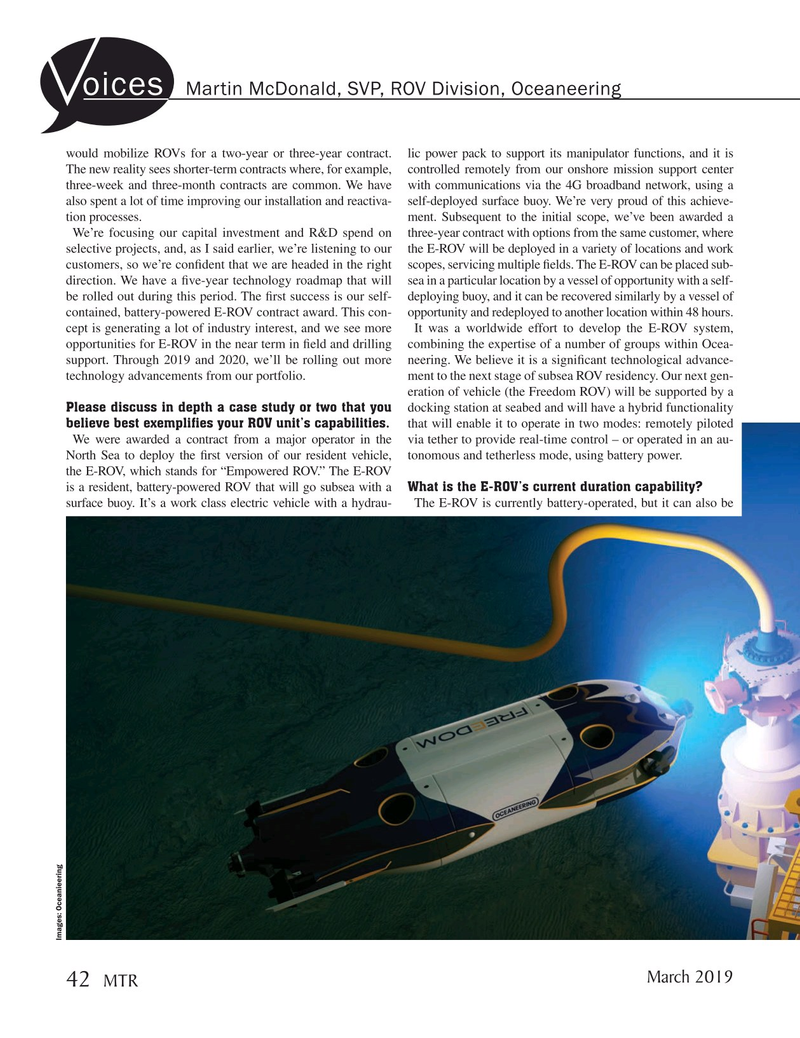
Page 42: of Marine Technology Magazine (March 2019)
Oceanographic Instrumentation: Measurement, Process & Analysis
Read this page in Pdf, Flash or Html5 edition of March 2019 Marine Technology Magazine
oices
Martin McDonald, SVP, ROV Division, Oceaneering would mobilize ROVs for a two-year or three-year contract. lic power pack to support its manipulator functions, and it is
The new reality sees shorter-term contracts where, for example, controlled remotely from our onshore mission support center three-week and three-month contracts are common. We have with communications via the 4G broadband network, using a also spent a lot of time improving our installation and reactiva- self-deployed surface buoy. We’re very proud of this achieve- tion processes. ment. Subsequent to the initial scope, we’ve been awarded a
We’re focusing our capital investment and R&D spend on three-year contract with options from the same customer, where selective projects, and, as I said earlier, we’re listening to our the E-ROV will be deployed in a variety of locations and work customers, so we’re con? dent that we are headed in the right scopes, servicing multiple ? elds. The E-ROV can be placed sub- direction. We have a ? ve-year technology roadmap that will sea in a particular location by a vessel of opportunity with a self- be rolled out during this period. The ? rst success is our self- deploying buoy, and it can be recovered similarly by a vessel of contained, battery-powered E-ROV contract award. This con- opportunity and redeployed to another location within 48 hours.
cept is generating a lot of industry interest, and we see more It was a worldwide effort to develop the E-ROV system, opportunities for E-ROV in the near term in ? eld and drilling combining the expertise of a number of groups within Ocea- support. Through 2019 and 2020, we’ll be rolling out more neering. We believe it is a signi? cant technological advance- technology advancements from our portfolio. ment to the next stage of subsea ROV residency. Our next gen- eration of vehicle (the Freedom ROV) will be supported by a
Please discuss in depth a case study or two that you docking station at seabed and will have a hybrid functionality believe best exempli? es your ROV unit’s capabilities. that will enable it to operate in two modes: remotely piloted
We were awarded a contract from a major operator in the via tether to provide real-time control – or operated in an au-
North Sea to deploy the ? rst version of our resident vehicle, tonomous and tetherless mode, using battery power.
the E-ROV, which stands for “Empowered ROV.” The E-ROV is a resident, battery-powered ROV that will go subsea with a What is the E-ROV’s current duration capability?
surface buoy. It’s a work class electric vehicle with a hydrau- The E-ROV is currently battery-operated, but it can also be
Images: Oceanieering
March 2019 42
MTR
MTR #2 (34-49).indd 42 3/11/2019 11:33:23 AM

 41
41

 43
43
